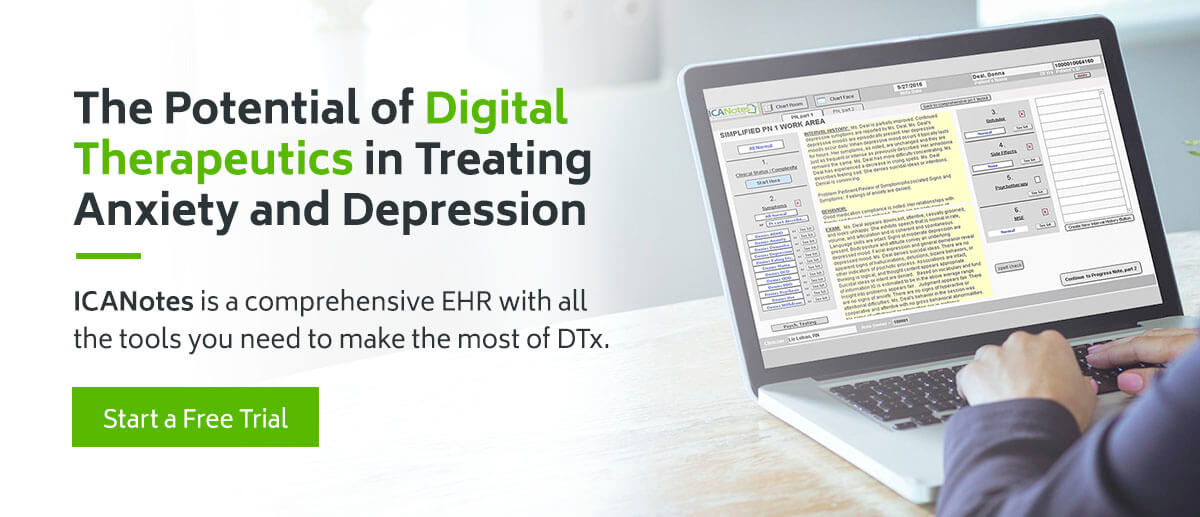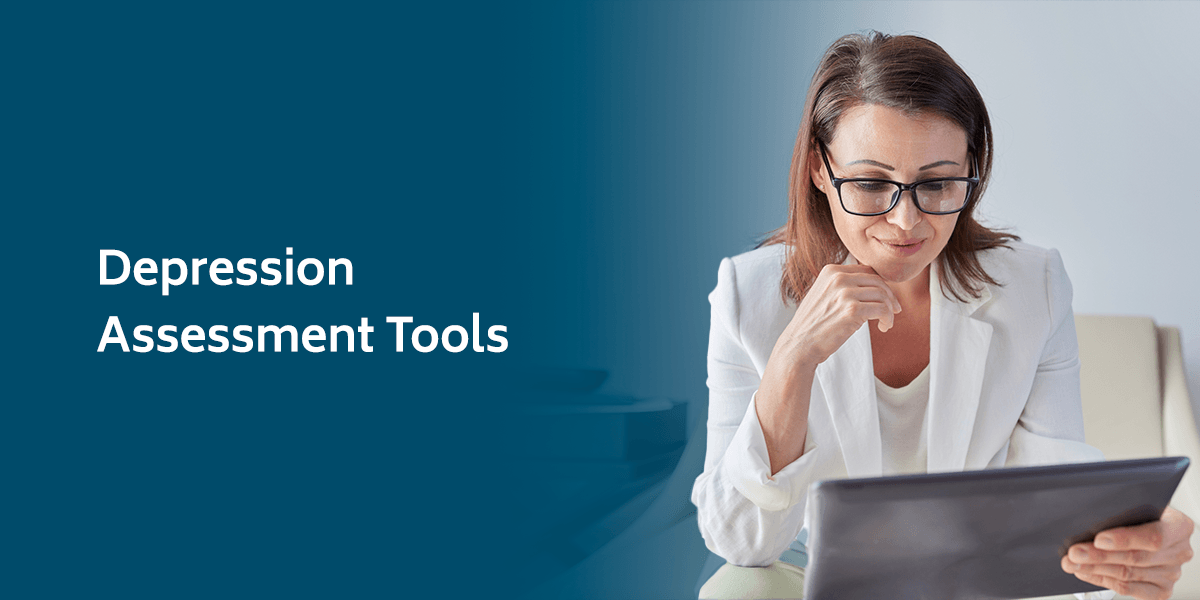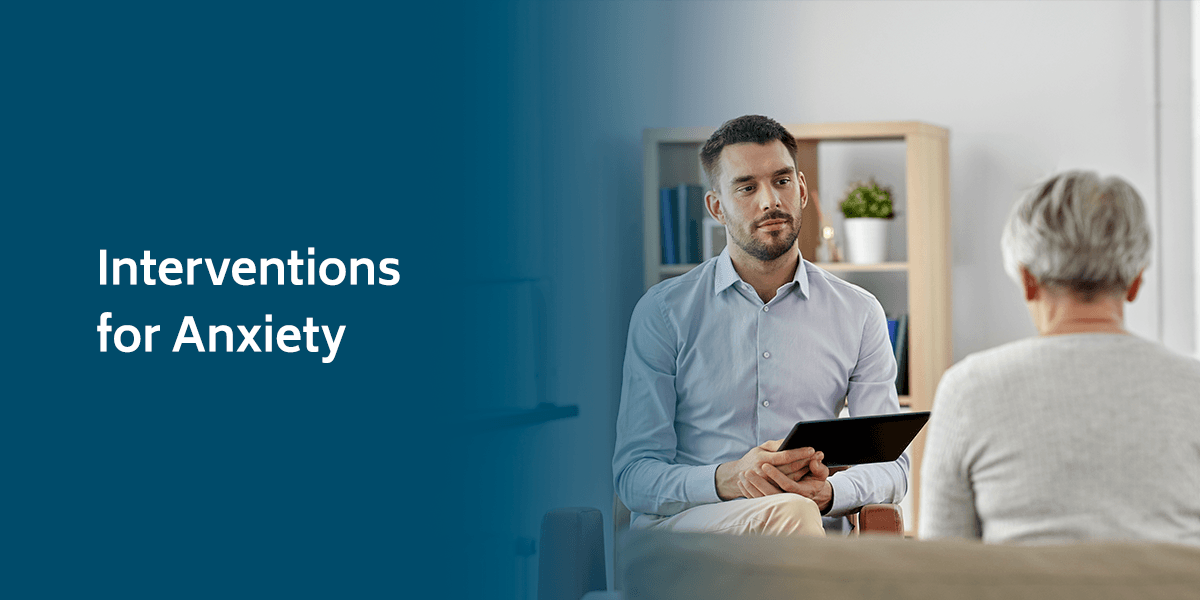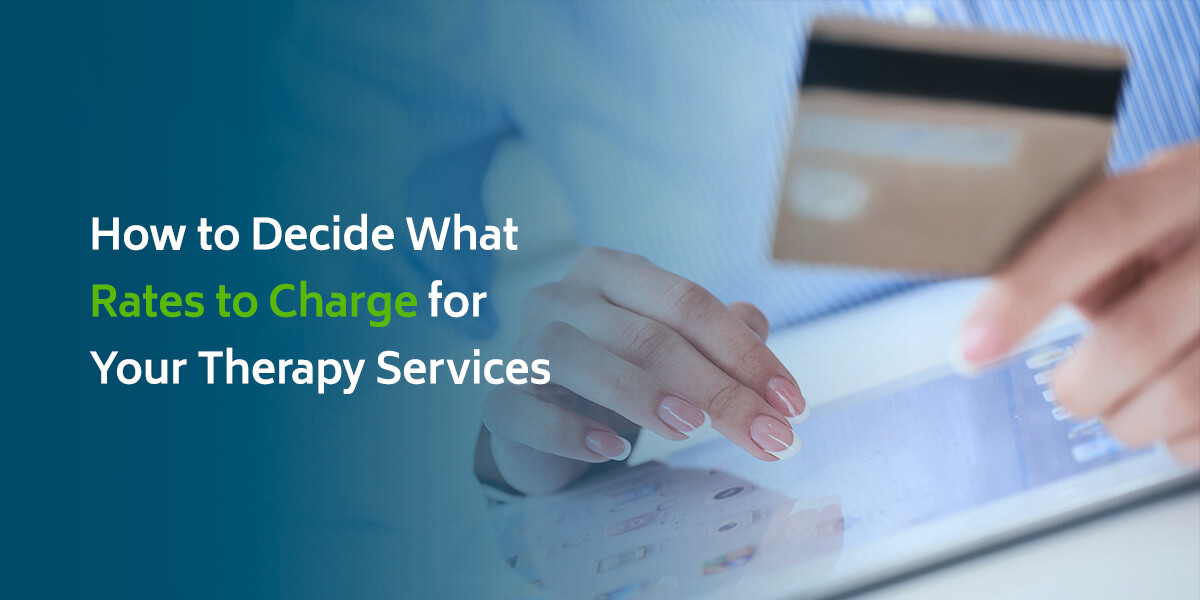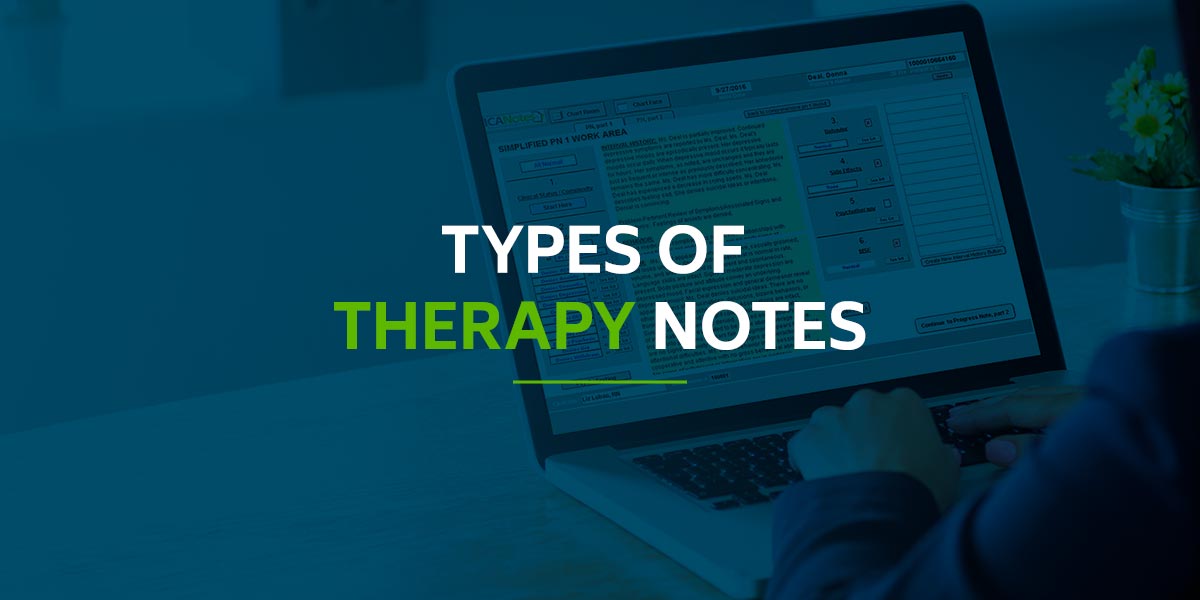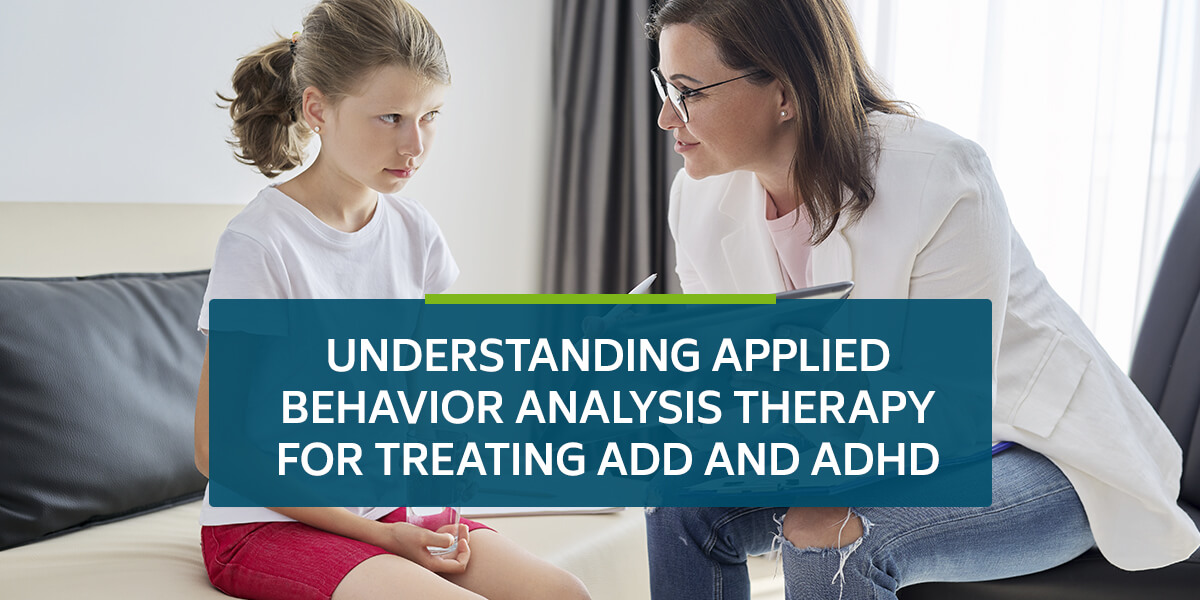Digital Therapeutics for Treating Anxiety and Depression
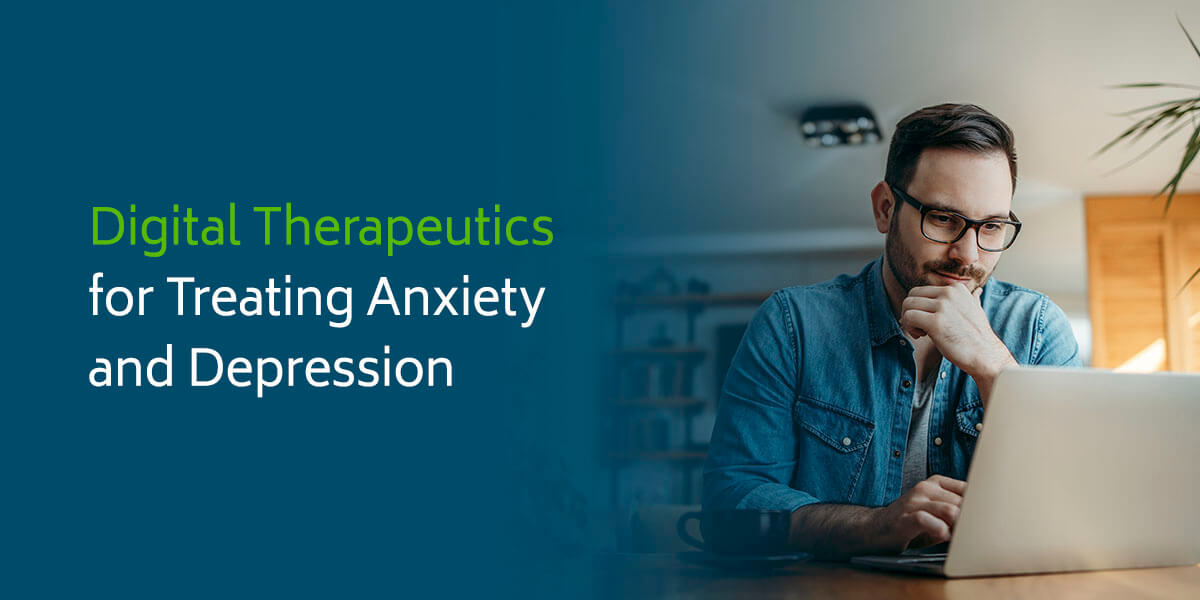
Using Digital Therapeutics to Treat Anxiety and Depression
People use technology in almost every part of their lives, from buying coffee to doing their taxes to visiting their doctor. Now, they can use it for anxiety and depression treatment. Digital therapeutics (DTx) offer a promising and quickly growing area of behavioral health treatment. These treatments leverage the convenience of apps and software to help patients complete or augment their anxiety treatment, stay compliant with exercises and keep their physicians informed.
But DTx are unique to other treatments, like medications or surgeries. Since technology moves so quickly, a slow approval process means they could be out of date by the time the product reaches the market. Fortunately, regulations are changing to meet these needs, ideally allowing everyone involved to offer the optimal balance of evidence-based support and real-world viability.
The behavioral health issues field seems to be a particularly good fit for digital therapeutics. Considering anxiety disorders are the most prevalent in the United States, more convenient, wide-reaching treatment tools can make a big difference.
Happify's Digital Therapeutic for Anxiety and Depression
One anxiety-focused DTx app that's currently in development comes from the company Happify. They've created Ensemble, an app designed to be an adjunctive treatment for major depressive disorder (MDD) and generalized anxiety disorder (GAD) in adults aged 22 or older. The app uses artificial intelligence (AI) to guide patients through activities based on cognitive behavioral therapy, positive psychology and mindfulness. During these daily activities, patients learn to shift away from negative thoughts and build their coping skills.
Ensemble uses science-backed activities and clinically validated assessments like the Patient Health Questionnaire-9 and Generalized Anxiety Disorder-7. The physician is looped into patient care and receives updates through a dashboard. They can collect more information about patient progress and outcomes data.
While Ensemble is not yet cleared by the Food and Drug Administration (FDA), Happify is currently conducting studies and plans to submit it for clearance, likely sometime in 2023. Currently, the app is not available without a prescription or outside of Happify's study. The app is designed to complement an existing treatment plan, supporting patients as they work through skills they learn with their clinician and explore new ones.
In April 2020, the FDA carved out a path for Ensemble upon seeing the need for more digital care options. The FDA eliminated the need for 510(k) premarket clearance for computerized behavioral therapy and other devices for treating psychiatric disorders during the public health emergency of COVID-19. We'll go over the regulation in more detail later, but this temporary suspension played a large role in getting Happify created.
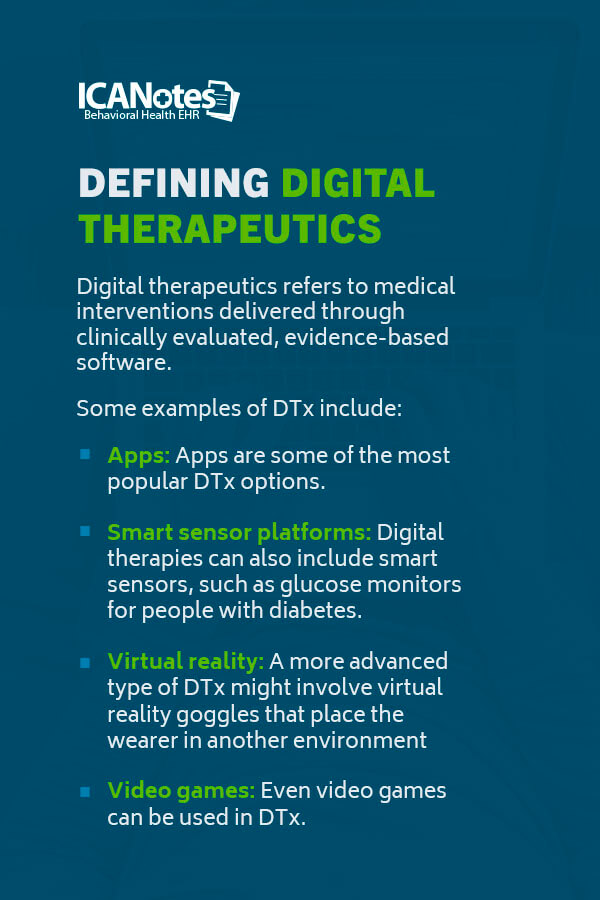
Defining Digital Therapeutics
Digital therapeutics refers to medical interventions delivered through clinically evaluated, evidence-based software. They reach the patient directly and can be used for treating, managing and preventing a wide array of disorders and diseases. They are often used as adjunctive therapy, designed to increase patient access to safe, effective strategies and eliminate gaps in care. Often, DTx are based on cognitive-behavioral therapy (CBT), the current gold standard for psychotherapy.
Some examples of DTx include:
- Apps: Apps are some of the most popular DTx options. Almost everyone in the U.S. has a cell phone, and 85% have a smartphone. Those numbers vary across demographics, but the vast majority of people own a smartphone, especially young people, making apps a highly accessible option. Apps can be easily personalized and updated, and patients are already familiar with the base system. Apps are a great fit for guiding patients through certain activities and tracking progress. An app could walk someone through their physical therapy exercises, help them access resources for substance abuse recovery or guide someone with insomnia through bedtime activities.
- Smart sensor platforms: Digital therapies can also include smart sensors, such as glucose monitors for people with diabetes. A DTx solution might link glucose monitors with a smartphone app to assess readings or work in tandem with a nasal carbon dioxide sensor to guide breathing exercises.
- Virtual reality: A more advanced type of DTx might involve virtual reality goggles that place the wearer in another environment, such as a triggering environment for post-traumatic stress disorder (PTSD) treatment or exposure therapy. Another application might be rehabilitative motions for those recovering from neurological disorders.
- Video games: Even video games can be used in DTx. EndeavorRx is an example of a video game that's been approved for treating attention-deficit/hyperactivity disorder (ADHD) in children.
If we look at anxiety-centered DTx, one of the more popular options is apps, which are also available for illnesses like depression and panic disorder.
Many DTx apps may look similar to wellness apps that have flooded the industry, but DTx goes through a more rigorous, targeted process. They are held to higher standards and target specific disorders or diseases. A prescription is typically required. Wellness or fitness apps generally aren't regulated and don't need to show clinical evidence and testing that proves their efficacy. Notably, these apps might also have lax security standards.
The efficacy of these DTx apps is significant. While Ensemble is still undergoing testing, Happify's original app has shown a 28.5% reduction in anxiety symptoms and long-lasting effects. Another DTx option, Daylight, showed that 71% of patients achieved clinical improvement in their anxiety. An insomnia app, Somryst, reduced insomnia symptoms by 45%. These promising results illustrate the real-world clinical effects of DTx.
Uses and Potential of Digital Therapeutics Technology
Healthcare's sudden shift to digital and remote care — along with the regulation changes that followed — helped boost DTx's popularity. These platforms fill an important gap when in-person care is hard to come by and can improve care during typical treatments. DTx are often based on CBT, which is a great fit for these products. This therapy relies on the patient using CBT strategies in their environment. They need to break their existing maladaptive ways of thinking and use their newfound skills in context with their life.
For many patients, transferring what they learn in therapy into the real world is challenging. The therapist may assign homework, but many patients will forget about it or lose motivation, a common issue for those with certain diagnoses, like MDD. DTx apps allow patients to continuously practice their skills in an easy-to-use and convenient platform. They can boost familiarity with the concepts and hone their ability to shift away from negative thoughts with more frequent, high-quality interventions. Studies have linked homework adherence with significant response and remission improvements for people with depression.
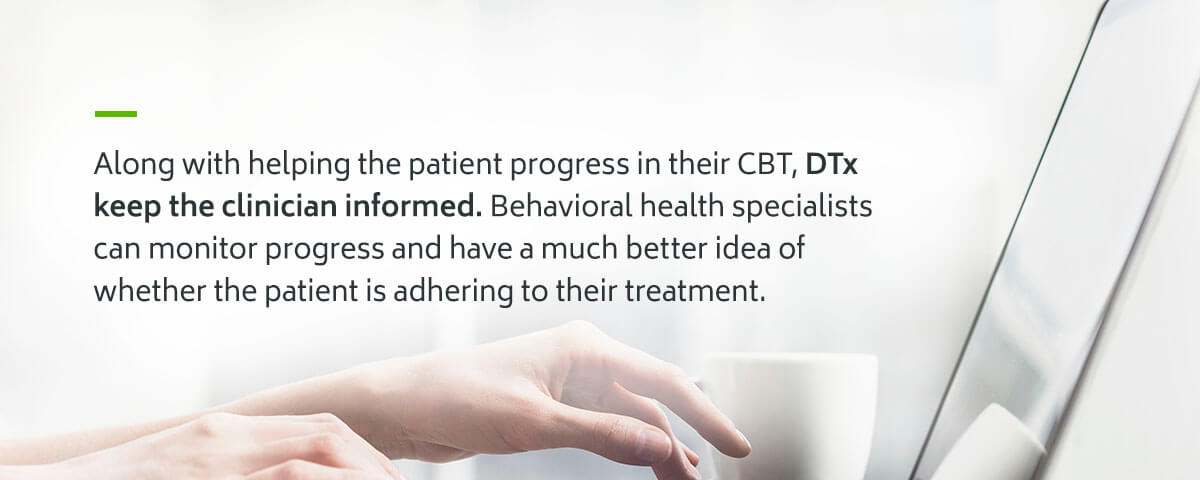
Along with helping the patient progress in their CBT, DTx keep the clinician informed. Behavioral health specialists can monitor progress and have a much better idea of whether the patient is adhering to their treatment. With insights from DTx apps, clinicians can adjust treatment plans as needed. Ensemble even steps in if the patient indicates thoughts of self-harm, connecting them to immediate resources.
The basic principle of DTx is useful on its own, but here are some other ways it combats barriers to care and fills in gaps in behavioral health.
Increasing Patient Access
Barriers to mental health services are plentiful — almost 60% of adults with a mental illness don't receive treatment. Disparities exist for several populations, insurance coverage or financial situations can vary widely and the stigma around behavioral health can prevent many from seeking care. Those who do seek care may struggle to find a provider. The Kaiser Family Foundation estimates that the U.S. has just 28.1% of the practitioners needed to provide appropriate mental health coverage for the population.
DTx solutions are a cost-effective approach to therapy that supports patients between visits. Say a patient has financial barriers to care and can rarely afford in-person visits. Maybe their provider is booked out for weeks, or the patient lives far away and won't make the drive very often. A DTx app can provide ongoing support between sessions and help more patients access quality care. It may even help clinicians balance high caseloads by offering hands-off support at home.
Improving Adherence
Many patients struggle to follow through with behavioral health treatments. They may forget medications, forego their CBT homework or put off visits due to inconvenience or aversion to the session itself. Digital therapeutics can help here, too. It's tough to beat the convenience of an app, and activities can be done from the comfort and privacy of the patient's home. Reminder notifications can also keep CBT top of mind.
Informing Treatment
Traditionally, therapists only get to assess patient progress during visits. DTx can offer much more information about the patient's day-to-day experiences. Daily activities provide insight into how the patient is responding to different situations and settings, helping the clinician adjust treatment and intervene when necessary.
Supporting Patient-Centered Care
Many practices are working toward patient-centered care, in which the patient takes an active role in their health. This concept is especially relevant in CBT, which requires “buy-in” from the patient to make foundational changes in their thinking patterns. DTx empower the patient to take charge in their anxiety treatment and work toward progress every day. Patients can access resources at any time, see their progress and take ownership of their treatment.
Regulating Digital Therapeutics
Digital therapeutics have some unique effects on regulation. Most medical treatments go through long testing processes before being made available to the public. If DTx go through the same process, they'll likely be outdated by the time they reach the market. Technology moves faster than typical approval processes can occur. But we can't throw away the research because that's what makes these products trustworthy and clinically viable. The digital therapeutics market, along with clinicians and regulating bodies, is looking to find balance between speed-to-market and clinical research.
We already mentioned one of the ways that's happening — the FDA's loosening of regulatory requirements. It removed several time-consuming steps for clearance so these technologies could be quickly pushed out to the public, providing more remote care options during the pandemic. In doing so, the FDA also touched on a key difference between DTx and other therapies: the risks of faster approval for DTx typically aren't as concerning.
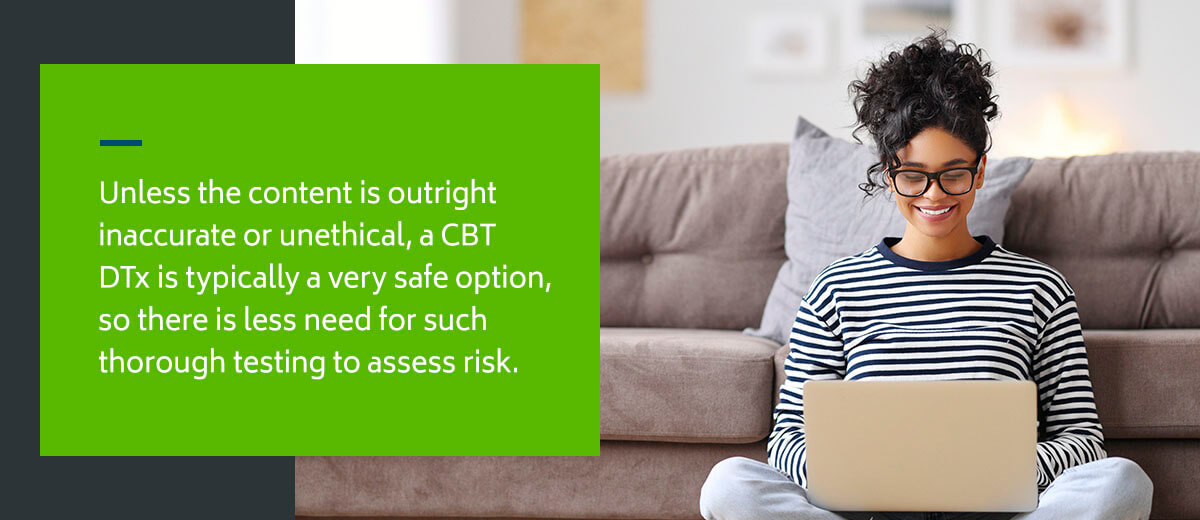
While drugs need to be thoroughly tested for potential interactions, side effects, chemical behavior and countless other concerns, apps don't have the same biological effects. CBT is generally assumed to have very little risk, aside from emotional discomfort. Unless the content is outright inaccurate or unethical, a CBT DTx is typically a very safe option, so there is less need for such thorough testing to assess risk.
Of course, we still want to ensure rigorous testing to assess efficacy, which brings us back to the problem of quickly evolving technology. While it poses a challenge for regulators, this quality is a boon for developers and providers. Unlike traditional medical devices, software can be rapidly updated. Developers can offer simple updates like security patches or redesign the entire interface when needed.
Many of these changes will be informed by user experiences and feedback. Effective software is dynamic and will change significantly in response to insight from real users. Traditional regulations don't allow for that kind of ongoing change. If the product advances significantly from what was initially reviewed, it would require an entirely new review.
One strategy the FDA is piloting is a Digital Health Software Precertification Program. Instead of certifying individual products, this program looks to certify companies. The certification will analyze various elements of the company, like transparency, infrastructure, risk management and continuous improvement, to determine that it will continue to offer high-quality, trustworthy and effective treatments as it develops the DTx over time.
The program is notable and shows that the FDA is receptive to the changes in regulation that need to happen to make DTx a viable and effective option.
The Future of Digital Therapeutics
Digital therapy is still in its early days, but there is a lot to look forward to. The capabilities of DTx are extensive, and regulators are adapting to the needs of the market and patients alike. As technology continues improving, we can expect a sizable growth in DTx. Market predictions give this industry a compound annual growth rate of 20.6% by 2030.
Insurance companies are also interested in supporting DTx. Across different types of insurance providers, 22%-31% already provide DTx coverage, while 44%-56% are interested in doing so. Greater coverage can expand access to DTx and help more patients benefit from them while providing the necessary funding for these rigorous platforms.
Artificial intelligence (AI) is also a powerful player in the future of DTx. Healthcare hasn't always been keen on AI due to the need for personalized care and trust between patient and provider. Still, AI can be an excellent addition to DTx. Pattern-recognition skills allow it to make predictions and offer more targeted care, while natural language processing allows for “conversations” that feel more like a therapy or journaling session. AI might allow DTx to work proactively, providing clinicians with relevant information and offering immediate solutions in emergencies, such as thoughts of self-harm.
The Potential of Digital Therapeutics in Treating Anxiety and Depression
As some of the most prevalent mental illnesses in the country, anxiety and depression can benefit from the wide-reaching benefits of DTx. These solutions provide 24/7 access to treatment resources, help patients practice therapeutic activities and fill the gap between the numbers of available providers and people who need treatment.
Ensemble and apps like it can play a big role in care, especially for clinicians looking to offer modern solutions and deliver more comprehensive care. DTx can take a major part in developing a 360-degree view of health for patients with anxiety and depression. Clinicians can easily fold the data into their electronic health record (EHR), tracking assessments and more detailed progress over time for more informed treatment planning.
ICANotes is a comprehensive EHR with all the tools you need to make the most of DTx. Explore its features online or reach out to us to start a free trial.
Sources
- https://medcitynews.com/2021/07/happify-rolls-out-digital-therapeutic-for-anxiety-depression-under-temporary-fda-guidance/
- https://www.frontiersin.org/articles/10.3389/fpsyt.2018.00004/full
- https://www.pewresearch.org/internet/fact-sheet/mobile/
- https://dtxalliance.org/products/endeavor/
- https://www.getensemble.com/public/ensemble-science/index.html
- https://dtxalliance.org/products/daylight/
- https://dtxalliance.org/products/somryst/
- https://pubmed.ncbi.nlm.nih.gov/30824246/
- https://mhanational.org/issues/2020/mental-health-america-access-care-data#adults_ami_no_treatmentt
- https://www.kff.org/other/state-indicator/mental-health-care-health-professional-shortage-areas-hpsas/?currentTimeframe=0&sortModel=%7B%22colId%22:%22Location%22,%22sort%22:%22asc%22%7D
- https://www.mayoclinic.org/tests-procedures/cognitive-behavioral-therapy/about/pac-20384610
- https://www.fda.gov/medical-devices/digital-health-center-excellence/digital-health-software-precertification-pre-cert-program
- https://www.alliedmarketresearch.com/digital-therapeutics-market
- https://www.insiderintelligence.com/insights/digital-therapeutics-report/

